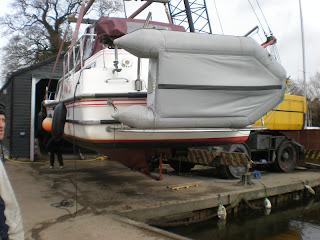Today’s assignment was on this Aquafibre 38 River Crusier down at Norfolk Yacht Agency at Horning. A dual steer cruiser launched in the late 80's to be the first dual steer cruiser to be able to pass under Potter Heigham bridge, Norfolk at low water. The models low air draught is complemented by sleek lines and good use of internal space. Later models were improved by the addition of a stern door, with early models only access point being through the external flybridge.
History: Aquafibre was founded at Neatishead, Norfolk in the 1960's by a consortium of local boat-builders. The majority shareholders were Robert Richardson and John Linford, who had 30% equity each. The remainder was divided between Martin Broom (Broom Boats - 15%), Vicktor Bell (Bell Boats - 10%), David Millbank (Jenners of Thorpe 10%) and Dawncraft of Wroxham (5%). Dawncraft soon sold their share to David Millbank. John Linford was tragically killed in a light aircraft crash and his share was sold to Martin Broom.
Robert Richardson felt that he was the main customer of the business and so sold his share to Martin Broom around 1975 to embark on his own operation. It is not known (by us, at least) what the current shareholding is, however Aquafibre is often identified as being Broom's 'sister' company and almost all of their boats have been moulded at Wendover Road.
Aquafibre also provide mould development and consultancy services for many other major boatbuilders as well as producing their extensive range of models from the current Rackheath facility. Sadly, in May 2009 the vast Wendover Road site at Rackheath closed its doors for the very last time. Production of sister company Broom's mouldings moved entirely to their Brundall site, with key Aquafibre customer Haines doing the same for their models built at Catfield.
Surveyors comments: Winter lay up / Electrical System:
All main electrical connections should be checked for corrosion before laying up for the winter. Once they are corrosion free, they should be sprayed with WD40 or equivalent so that they won't corrode in the damp weather. The batteries are very susceptible to damage during the winter season and should be cared for in the following manner. They should be disconnected and the terminals should be cleaned. The electrolyte level should be checked and topped up if necessary. The batteries should be fully charged. Ideally the batteries should be removed and kept indoors for the winter as sub-zero temperatures are not good for them. Also ideally they should be re-charged every month during the winter as the charge will slowly drain over a long period of time.
Thinking of Buying a Boat and Need Help? I specialise in Boats of all types, and I will assist you to make an informed decision. Contact me for a detailed and comprehensive report at: steventruss1@aol.com
History: Aquafibre was founded at Neatishead, Norfolk in the 1960's by a consortium of local boat-builders. The majority shareholders were Robert Richardson and John Linford, who had 30% equity each. The remainder was divided between Martin Broom (Broom Boats - 15%), Vicktor Bell (Bell Boats - 10%), David Millbank (Jenners of Thorpe 10%) and Dawncraft of Wroxham (5%). Dawncraft soon sold their share to David Millbank. John Linford was tragically killed in a light aircraft crash and his share was sold to Martin Broom.
Robert Richardson felt that he was the main customer of the business and so sold his share to Martin Broom around 1975 to embark on his own operation. It is not known (by us, at least) what the current shareholding is, however Aquafibre is often identified as being Broom's 'sister' company and almost all of their boats have been moulded at Wendover Road.
Aquafibre also provide mould development and consultancy services for many other major boatbuilders as well as producing their extensive range of models from the current Rackheath facility. Sadly, in May 2009 the vast Wendover Road site at Rackheath closed its doors for the very last time. Production of sister company Broom's mouldings moved entirely to their Brundall site, with key Aquafibre customer Haines doing the same for their models built at Catfield.
Surveyors comments: Winter lay up / Electrical System:
All main electrical connections should be checked for corrosion before laying up for the winter. Once they are corrosion free, they should be sprayed with WD40 or equivalent so that they won't corrode in the damp weather. The batteries are very susceptible to damage during the winter season and should be cared for in the following manner. They should be disconnected and the terminals should be cleaned. The electrolyte level should be checked and topped up if necessary. The batteries should be fully charged. Ideally the batteries should be removed and kept indoors for the winter as sub-zero temperatures are not good for them. Also ideally they should be re-charged every month during the winter as the charge will slowly drain over a long period of time.
Thinking of Buying a Boat and Need Help? I specialise in Boats of all types, and I will assist you to make an informed decision. Contact me for a detailed and comprehensive report at: steventruss1@aol.com





No comments:
Post a Comment
Hi, how can I help?